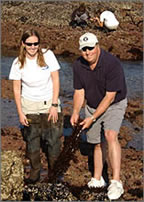Scientist Explores Rocky Shore Life and the Impact of Human Activities
November 20, 2006
By Debra Cano Ramos
For more than 30 years, Steven N. Murray, dean of the College of Natural Sciences and Mathematics and a professor of biological science, has been studying the ecology of rocky shore plants and animals and how human activities have impacted these organisms.
Now he has penned his first book on the subject in collaboration with two other experts in the field: Richard F. Ambrose, director and professor of environmental science and engineering at UCLA, and Megan N. Dethier, associate research professor of biology at the University of Washington.
Research and agency sciences, as well as university students, are expected to use “Monitoring Rocky Shores.” The book, published in October by University of California Press, will provide investigators with information on how to develop methods and procedures for carrying out key elements of a rocky intertidal field-sampling program.
Monitoring changes in the number of organisms living on rocky shores is critical to determining the effect people have on these highly accessible habitats, Murray said, adding that “there is much interest in learning how these organisms are responding to increasing human pressures and changing environmental conditions.”
Over the last decade, Murray has received more than $1.7 million in grants to conduct research on the ecology of rocky shores, including about $434,000 from the U.S. Interior Department’s Minerals Management Service to carry out shoreline monitoring. The monitoring program provides information on changing abundances of key rocky intertidal species along the Orange County coast and serves as a foundation for evaluating the impact of major environmental disturbances, such as an oil spill.
Murray’s monitoring program is part of the Multi-Agency Rocky Intertidal Network (MARINe), which is monitoring shoreline resources from San Diego to Oregon. Scientists from federal, state and local government agencies (including Minerals Management Service), universities and private and volunteer organizations are members of MARINe. Key rocky intertidal habitats and species are sampled every fall and spring using a variety of methods. Mussels, sea stars, abalone, surf grass, acorn and goose-neck barnacles, and several algal species — such as rockweed and turf weed — are among the key species being studied.
The network is working toward developing a report card that would evaluate the health of rocky intertidal systems in California, Murray said.
Recently, Murray also received a nearly $6,000 Minerals Management Service grant to create a digital video demonstrating various elements of the rocky intertidal sampling protocols used by MARINe.
The video will be used as an educational tool for university students, scientists and government agency personnel who will be able to download the information from the MARINe Web site.
“The purpose will be to provide Web-based, downloadable video of different types of sampling procedures,” Murray said. “This will allow a new member of a MARINe monitoring group or a student in a university classroom to visualize how to actually carry out a particular sampling technique.”
Cheryl Aranda, assistant to the NSM dean, and her son, Michael, a third-year film student at Brooks Institute of Photography in Ventura, will be working on the video.
Aranda (B.A. communications-radio, TV, film ’87), who moonlights as a singer and songwriter, sees this as an opportunity to work in her field of college study. The video will be completed in about a year.


 Produced by the Office of Public Affairs at California State University, Fullerton.
Produced by the Office of Public Affairs at California State University, Fullerton.